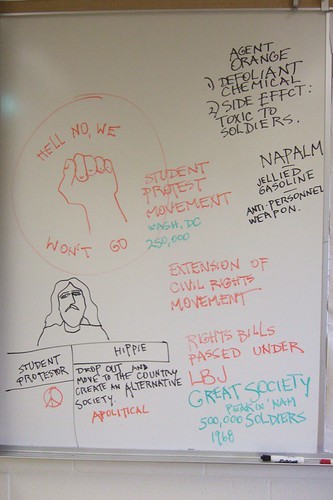The movement against the involvement of the United States in the Vietnam War began in the U.S. with demonstrations in 1964 and grew in strength in later years.
The U.S. became polarized between those who advocated continued involvement in Vietnam ("Hawks"), and those who wanted peace ("Doves").
Many in the peace movement were students, mothers, or long-haired anti-establishment types, says Wikipedia.
Also involved were educators, clergy, academics, journalists, lawyers, physicians (such as Benjamin Spock and Justin Newlan), military veterans, and ordinary Americans.
Expressions of opposition events ranged from peaceful nonviolent demonstrations to radical displays of violence.
In 1967, Civil rights leader Martin Luther King led a march of 5,000 against the war in Chicago, Illinois. He was assassinated in 1968.
Also in 1967 400,000 people marched from Central Park to the UN building in New York City to protest the war, where they were addressed by critics of the war such as Benjamin Spock and Martin Luther King. On the same date 100,000 marched in San Francisco.
In 1968 the Tet Offensive was launched and resulted in much higher casualties and changed perceptions of the state of the war.
In 1969 crowds estimated up to half a million people participated in an anti-war demonstration in Washington, D.C. A similar demonstration was held in San Francisco.
Protests continued - against Nixon's bombing of N Vietnam - through 1972.
skip to main |
skip to sidebar
For students and parents who love education and exploration of the social sciences . . .
Search This Blog
Followers
Blog Archive
-
▼
2012
(254)
-
▼
April
(33)
- Mandala: a circle that reflects the art and belief...
- Buddhism, Tibet, the mandala, the Dalai Lama, Om a...
- India review quiz
- Danh's Garden and Pho Kim are Vietnamese restauran...
- At the end of the civil rights movement young Amer...
- Angkor wat: ancient and vast temple complex in n C...
- Five presidents involved in Vietnam
- Attend Artbreak 2012 and get bonus points in socia...
- The Buddha: the Siddhartha Gautama quiz
- Magnet geography / intro to the Vietnam Conflict
- One-page interview with Vietnam Conflict Veteran(s...
- India / quiz questions
- Samosas: the snack food of India and Central Asia
- Civil Rights Movement in the US was based on Gandh...
- Sadhu in Nepal
- Amritsar. India, center of the Punjab region
- The life of Siddhartha Gautama
- 1930: civil disobedience in India via the Salt March
- Magnet geography: yoga is a discipline born in anc...
- Yoga, an ancient Hindu devotion that has become a ...
- Tandoor Oven - Chandigarh, India
- Indie work: Bollywood and Hollywood or Gandhi and ...
- India's ancient rules for class organization: the ...
- Gandhi's modus operandi in social activism
- Sikhs and Gandhi
- Bangalore: city in the south of India that is the ...
- Symbol of technology and manufacturing in a new an...
- Turkmenistan: delegation from this Central Asian n...
- Gandhi, apostle of non-violent protest
- Gandhi: "An eye for an eye only makes the whole wo...
- Review quiz on the Taj Mahal
- Taj Mahal in Paper project: due next class for 8 pts
- Indie work: comparison essay on George Washington ...
-
▼
April
(33)

